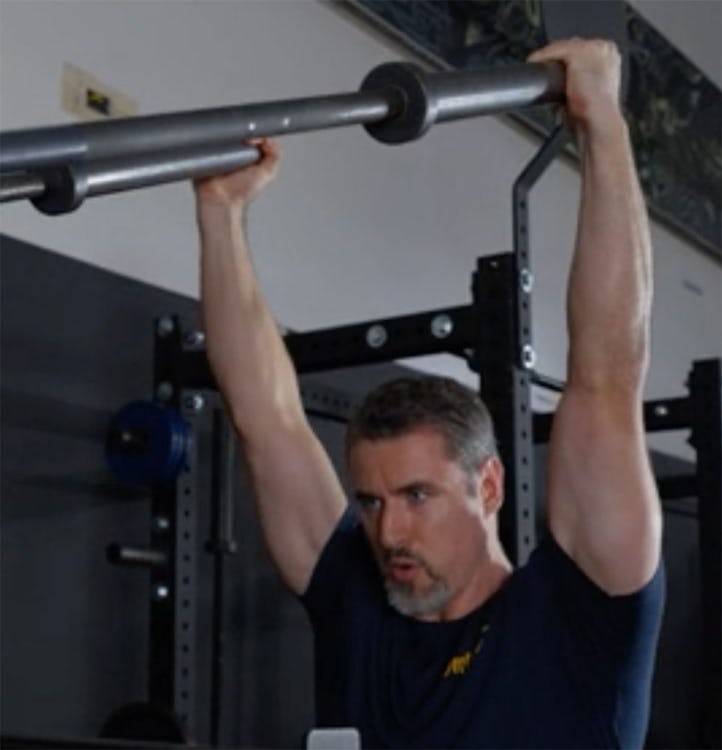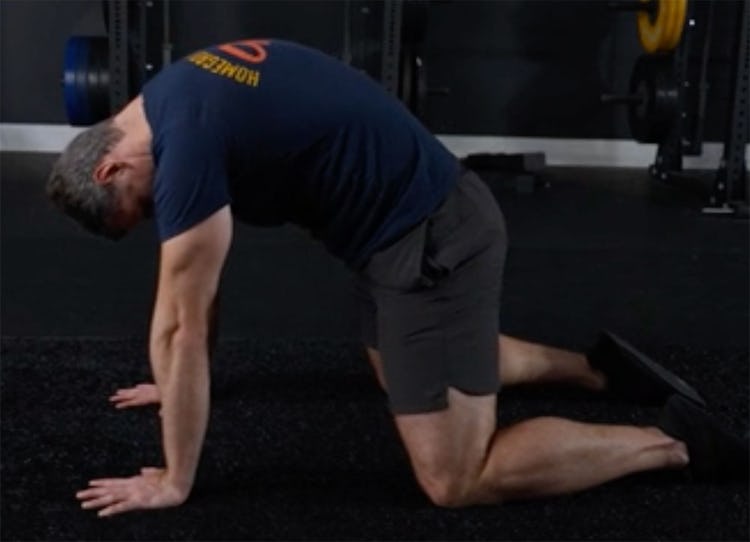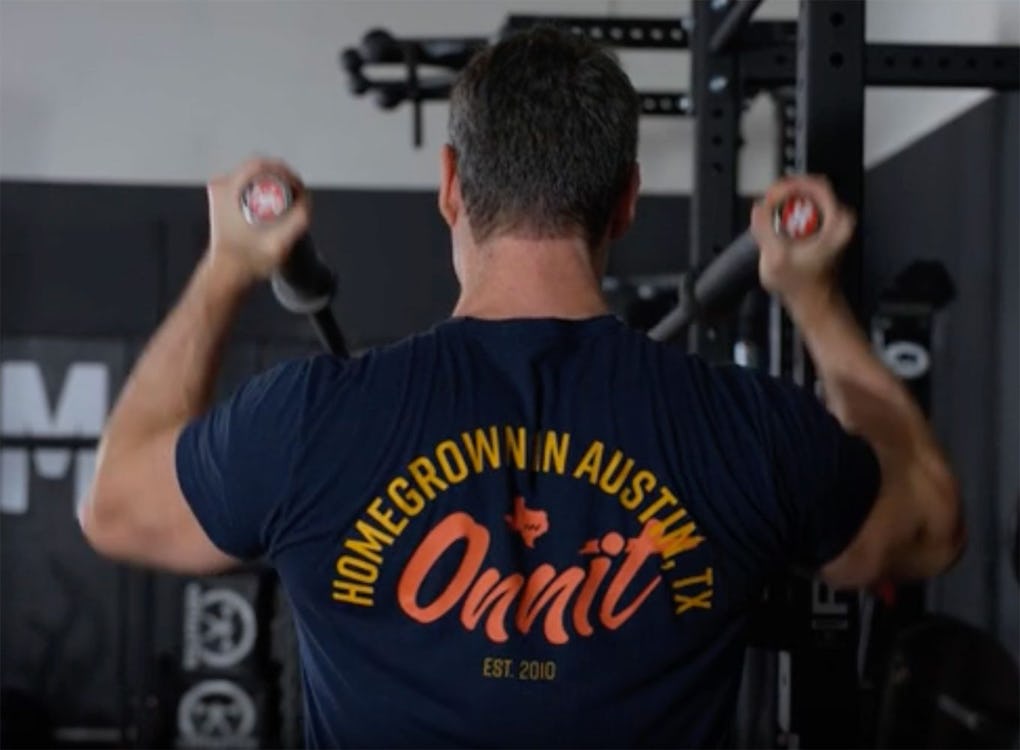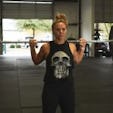The Viking press is a type of overhead press that builds the shoulders and triceps, and it’s a good alternative to standard barbell pressing if you have injuries you need to work around.
Key Takeaways
1. The Viking press is used in strongman competition and trains the shoulders and triceps.
2. The Viking press is joint-friendly and less stressful to the shoulders and low back than standard overhead presses.
3. You need two barbells and a power rack to perform the Viking press.
4. You can do landmine presses and dumbbell push presses in place of a Viking press.
5. Perform the Viking press for 2–3 sets of 5–8 reps to build muscle and strength. To build power, do 3–5 sets of 1–5 reps.
What Is The Viking Press and What Are Its Benefits?
(See 00:21 in the video above.)
Similar to a landmine press, the Viking press has you lifting the bar overhead in an arcing motion rather than straight up, as in a military press. Actually, if you want to do the Viking press in a public gym or at home, you’ll have to set it up with TWO bars that are parallel to each other in a power rack/cage. This is because most gyms won’t have the same kind of Viking press apparatus that strongmen train on—and that’s how the Viking press began.
The Viking press is often used in strongman competitions, and, while we can’t prove it, we suspect that that’s where the name comes from—since the sport has long been dominated by gigantic Scandinavians. It should come as no surprise, then, that the Viking press is a great way to build upper-body strength and muscle. (For more muscle-building tips and a training schedule, see our article on how often you should lift.)
The two-bar setup means that you’ll have to grip both barbells by their sleeves—the thick end of the bar where you load the weight plates. This will force you to use a neutral grip—palms facing in—and many people find that this position is easier on their shoulders than pressing with palms facing forward. The thickness of the sleeve also disperses the weight of the bar more evenly through your joints, so if your wrists, elbows, and shoulders tend to hurt doing normal barbell overhead presses, the Viking press may allow you to train pressing pain-free.
Yet another benefit is that the Viking press is safer for the low back. On the old-fashioned military press, the heavier the weight gets, the more people tend to lean back as they press, hyperextending their lower back, which can cause injury. With the Viking press, because you’re lifting the weight on an arc, it causes you to drive your body slightly forward. Doing so lets you keep your ribs down and your core braced, so your torso is one tight column that makes for stronger, safer pressing.
How To Do The Viking Press Correctly
(See 01:53 in the video.)

Admittedly, the Viking press is a bit complicated to set up. You need to have a power rack with safety guards and two equal-sized barbells to do it.
Step 1. Set the safety guards in the power rack. Place one at about shoulder level and the other one notch higher. Now place empty barbells on top of the guards. Set the ends of the barbells that you will hold to press on the lower guard so that the opposite end that serves as your fulcrum is higher. Now secure the higher ends of the barbells by loading 10-pound plates on the sleeves, and tuck the weights inside the safety guards so they rub against the guards. This is just to keep the bars in place so they don’t slide down the safety rods while you press.
Step 2. Now load the weight you’ll lift on the other side of the barbells. Grasp the ends of the bar sleeves and stand just behind the bars with your feet at shoulder width. Your wrists should be in line with your elbows. Draw your ribs down and brace your core.
Step 3. Press the bars upward to lockout until they’re straight overhead. Allow your bodyweight to shift forward as you press and push your head through so your arms end up in line with your ears.
You can also perform the Viking press the way strongman competitors do, which is more like a push press. You dip your knees quickly and use momentum to drive the weight up. This will allow you to lift heavier and it makes the exercise more of a total-body movement. Note that if you dip your knees you’ll need more room so that the bar doesn’t bang into the safety guard nearest you, so you may need to set that guard another notch lower.
What Muscles Does The Viking Press Work?
(See 03:15 in the video.)
The Viking press primarily strengthens the front and lateral deltoids, but the triceps will work hard too as you extend your elbows. Your traps and other back muscles, legs, and core will also get some activation.
How to Stretch Before Doing the Viking Press
(See 03:26 in the video.)
It’s a good idea to warm up both the shoulders and the thoracic spine before you get into any Viking pressing. Here are some movements that will prep both areas.
The Cat-Camel Stretch
(See 03:33 in the video.)

Step 1. Get on all fours and brace your core. Your arms should be directly under your shoulders and your knees under your hips.
Step 2. Press your arms into the floor while you round your upper back toward the ceiling, spreading your shoulder blades. Hold for a second.
Step 3. Now retract your shoulder blades while you arch your upper back and drive your solar plexus toward the floor. Hold for a second. That’s one rep. Imagine the motion as having a string running through your solar plexus with someone pulling it up and then down—try to move at the upper back and not the lower back. Do 2 sets of 10 reps.
Behind-The-Back Shoulder Rotations
(See 04:09 in the video.)
Step 1. Stand tall and place the back of one hand behind you and against your lower back. Place the palm of your other hand behind your head.
Step 2. Now pull your hands back an inch or so away from your head and low back, hold a moment, and then switch positions, rotating your shoulders to bring one hand to your head and the other to your lower back. That’s one rep. Do 2 sets of 10 reps.
Viking Press Alternatives
(See 05:03 in the video.)
OK, OK, so maybe the Viking press is a hassle to set up and you can’t monopolize a power rack and TWO barbells in your gym without getting dirty looks from your fellow gymgoers. In that case, you can try two alternatives that train the shoulders in a similar way.
Landmine Press
The landmine press is basically just a unilateral version of the Viking press done with the far end of the barbell on the floor. Lucky for you we recently shot a video and did a whole separate article on how to landmine press.
A really simple option B that anyone can do at home with a pair of dumbbells is the dumbbell push press. You won’t be able to go as heavy as with barbells, but the dumbbells will force you to control two weights independently, and they allow you to use that shoulder-friendly neutral grip.
Dumbbell Push Press
(See 05:35 in the video.)
Step 1. Stand tall with feet hip-width apart. Hold a heavy pair of dumbbells at shoulder level with your elbows forward so your forearms are vertical. Turn your wrists so your palms face in. Draw your shoulders back—think “proud chest”—and brace your core.
Step 2. Dip your knees very quickly while keeping your torso tall and straight, and then explode upward, straightening your knees to provide momentum as you press the weights straight overhead to lockout.
How To Fit The Viking Press Into Your Workouts
(See 06:14 in the video.)
If you normally do barbell overhead presses or push presses as your main strength lift in a workout, the Viking press can substitute for either and would be best used early on in your workout on an upper-body push or chest/shoulder day. Two to three sets of 5–8 reps are fine. If you want to do the strongman version where you dip your knees, which trains more total-body power, you could do 3–5 sets of 1–5 reps. Again, do this as your first or maybe second exercise of the day, after you’ve warmed up thoroughly, but are still fresh enough to be explosive.

)





